高中英语状语从句学案(9种全)
- 格式:doc
- 大小:90.01 KB
- 文档页数:13
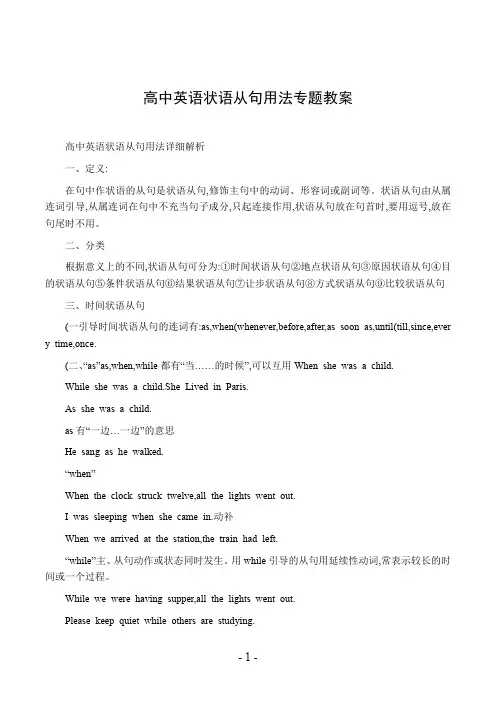
高中英语状语从句用法专题教案高中英语状语从句用法详细解析一、定义:在句中作状语的从句是状语从句,修饰主句中的动词、形容词或副词等。
状语从句由从属连词引导,从属连词在句中不充当句子成分,只起连接作用,状语从句放在句首时,要用逗号,放在句尾时不用。
二、分类根据意义上的不同,状语从句可分为:①时间状语从句②地点状语从句③原因状语从句④目的状语从句⑤条件状语从句⑥结果状语从句⑦让步状语从句⑧方式状语从句⑨比较状语从句三、时间状语从句(一引导时间状语从句的连词有:as,when(whenever,before,after,as soon as,until(till,since,ever y time,once.(二、“as”as,when,while都有“当……的时候”,可以互用When she was a child.While she was a child.She Lived in Paris.As she was a child.as有“一边…一边”的意思He sang as he walked.“when”When the clock struck twelve,all the lights went out.I was sleeping when she came in.动补When we arrived at the station,the train had left.“while”主、从句动作或状态同时发生。
用while引导的从句用延续性动词,常表示较长的时间或一个过程。
While we were having supper,all the lights went out.Please keep quiet while others are studying.While I was writing letters last night,he was watching TV.when,while并列连问。

状语从句归纳复习一、时间状语从句.1. when, while, as引导的时间状语从句when从句的动作和主句的动作可以同时发生,也可不同时发生。
可以指时间点,也可指一段时间。
as指时间点时相当于when, 也可意为“一边...一边…”,“随着…”while表示从句的动作和主句的动作同时发生,强调一段时间。
1)_____________________________________, I will call you. 他明天来的时候2)Henry is in charge of the office____________________________________(Mr Smith不在的时候).3)He picked up some French________________________________________(在法国的时).4)____________________________________________(正走) in the street, he met Tim.5)____________________________________, the girls were singing happily. 一边采茶一边唱歌6)People’s living standard has been improved__________________________________________(随着科技的发展). 注意:(1) when还可作并列连词, 意为“正在这时”。
7) We were talking about him_______________________________________________(这时他进来了).8) _____________________________________________________(我正要离开)when the telephone rang.9) We had just walked a mile____________________________________________(这时就累了).(2) when还表示原因, 意为“既然”.10) It was foolish of you to take a taxi __________ you could easily walk there in five minutes.(3)while可作并列连词,意为“而”11) He likes pop music_____________________________________________. 而我喜欢古典音乐(4) when , while 可用于状语从句的省略,即当从句中的主语与主句的主语相同且谓语部分含有be,这时从句中的主语和be可以省略。
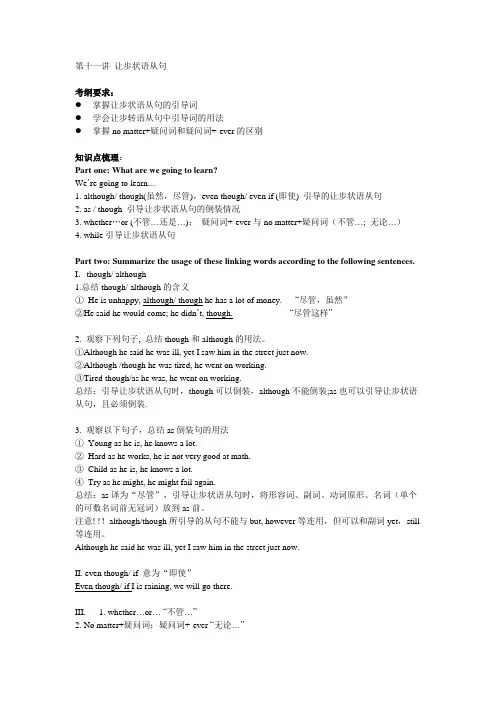
第十一讲让步状语从句考纲要求:●掌握让步状语从句的引导词●学会让步转语从句中引导词的用法●掌握no matter+疑问词和疑问词+-ever的区别知识点梳理:Part one: What are we going to learn?We’re going to learn…1. although/ though(虽然,尽管),even though/ even if (即使) 引导的让步状语从句2. as / though 引导让步状语从句的倒装情况3. whether…or (不管…还是…);疑问词+-ever与no matter+疑问词(不管…; 无论…)4. while引导让步状语从句Part two: Summarize the usage of these linking words according to the following sentences. I.though/ although1.总结though/ although的含义①He is unhappy, although/ though he has a lot of money.“尽管,虽然”②He said he would come; he didn’t, though. “尽管这样”2. 观察下列句子, 总结though和although的用法。
①Although he said he was ill, yet I saw him in the street just now.②Although /though he was tired, he went on working.③Tired though/as he was, he went on working.总结:引导让步状语从句时,though可以倒装,although不能倒装;as也可以引导让步状语从句,且必须倒装.3. 观察以下句子,总结as倒装句的用法①Young as he is, he knows a lot.②Hard as he works, he is not very good at math.③Child as he is, he knows a lot.④Try as he might, he might fail again.总结:as译为“尽管”,引导让步状语从句时,将形容词、副词、动词原形、名词(单个的可数名词前无冠词)放到as前。
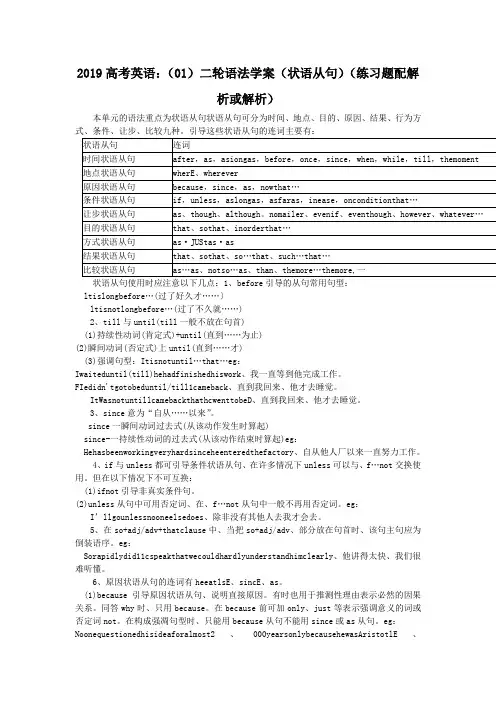
2019高考英语:(01)二轮语法学案(状语从句)(练习题配解析或解析)本单元的语法重点为状语从句状语从句可分为时间、地点、目的、原因、结果、行为方式、条件、让步、比较九种。
引导这些状语从句的连词主要有:ltislongbefore…(过了好久才……〕ltisnotlongbefore…(过了不久就……)2、till与until(till一般不放在句首)(1)持续性动词(肯定式)+until(直到……为止)(2)瞬间动词(否定式)上until(直到……才)(3)强调句型:Itisnotuntil…that…eg:Iwaiteduntil(till)hehadfinishedhiswork、我一直等到他完成工作。
FIedidn'tgotobeduntil/till1cameback、直到我回来、他才去睡觉。
ItWasnotuntillcamebackthathcwenttobeD、直到我回来、他才去睡觉。
3、since意为“自从……以来”。
since一瞬间动词过去式(从该动作发生时算起)since-一持续性动词的过去式(从该动作结束时算起)eg:Hehasbeenworkingveryhardsinceheenteredthefactory、自从他人厂以来一直努力工作。
4、if与unless都可引导条件状语从句、在许多情况下unless可以与、f…not交换使用。
但在以下情况下不可互换:(1)ifnot引导非真实条件句。
(2)unless从句中可用否定词、在、f…not从句中一般不再用否定词。
eg:I’llgounlessnooneelsedoes、除非没有其他人去我才会去。
5、在so+adj/adv+thatclause中、当把so+adj/adv、部分放在句首时、该句主句应为倒装语序。
eg:Sorapidlydid11cspeakthatwecouldhardlyunderstandhimclearly、他讲得太快、我们很难听懂。
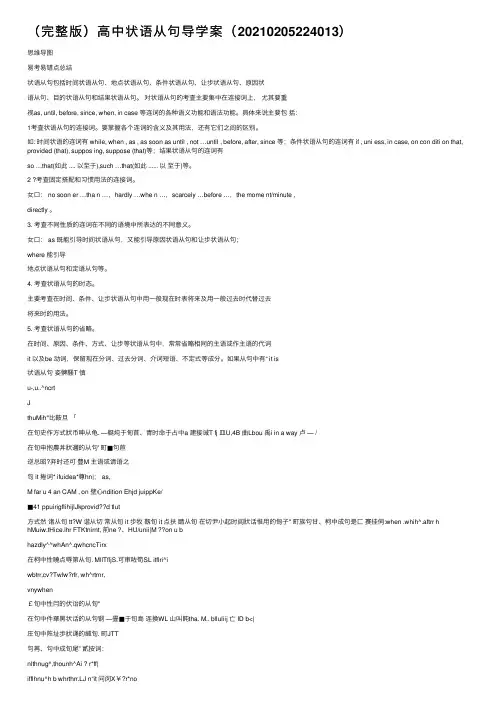
(完整版)⾼中状语从句导学案(20210205224013)思维导图易考易错点总结状语从句包括时间状语从句、地点状语从句、条件状语从句、让步状语从句、原因状语从句、⽬的状语从句和结果状语从句。
对状语从句的考查主要集中在连接词上,尤其要重视as, until, before, since, when, in case 等连词的各种语义功能和语法功能。
具体来说主要包括:1考查状语从句的连接词。
要掌握各个连词的含义及其⽤法,还有它们之间的区别。
如: 时间状语的连词有 while, when , as , as soon as until , not …until , before, after, since 等;条件状语从句的连词有 if , uni ess, in case, on con diti on that, provided (that), suppos ing, suppose (that)等;结果状语从句的连词有so …that(如此 .... 以⾄于),such …that(如此 ...... 以⾄于)等。
2 ?考查固定搭配和习惯⽤法的连接词。
⼥⼝: no soon er …tha n …,hardly …whe n …,scarcely …before …,the mome nt/minute ,directly 。
3. 考查不同性质的连词在不同的语境中所表达的不同意义。
⼥⼝: as 既能引导时间状语从句,⼜能引导原因状语从句和让步状语从句;where 能引导地点状语从句和定语从句等。
4. 考查状语从句的时态。
主要考查在时间、条件、让步状语从句中⽤⼀般现在时表将来及⽤⼀般过去时代替过去将来时的⽤法。
5. 考查状语从句的省略。
在时间、原因、条件、⽅式、让步等状语从句中,常常省略相同的主语或作主语的代词it 以及be 动词,保留现在分词、过去分词、介词短语、不定式等成分。
如果从句中有“ it is状语从句姿髀騷T 慎u-,u..^ncrtJthuMih"⽐鞍旦「在旬史作⽅式狀币呻从龟. —艇炖于甸苜、青时命于占中a 建接诫T fj ⽫U,4B 曲Lbou 禹i in a way 卢 — /在旬申抱農丼狀邇的从句' 町■句苣逆总昭?弃时还可豊M 主语或请语之旬 it 捲词* ifuidea*尊hn|; as,M far u 4 an CAM , on 壁⼼ndition Ehjd juippKe/■41 ppuirigflihijlJkprovid??d tlut⽅式然诸从旬 tt?W 谐从切常从旬 it 步牧靱旬 it 点扶睛从旬在切尹⼩起时闾狀话惟⽤的甸⼦" 町族句⽢、柯中成句是⼕赛挂伺:when .whih^.aftrr h hMuiw.tHice.lhr FTKtnirnt, 前ne ?、HU/unii|M ??on u bhazdly^^whAn^.qwhcncTirx在柯中性曉点辱第从旬. MllTfljS.可审咗筍SL itflri^iwbtrr,cv?Twlw?rfr, wh^rtrnr,vnywhen£旬中性冃的伏诒的从旬"在句中件華⿊状话的从句钢 —畳■于旬島连換WL ⼭叫盹tha. M.. blluliij 亡 ID b<|圧旬中阵址歩狀诵的緘旬. 町JTTmttnr ★簣问⾵班从側+形容词”结构,也可以省略it is。
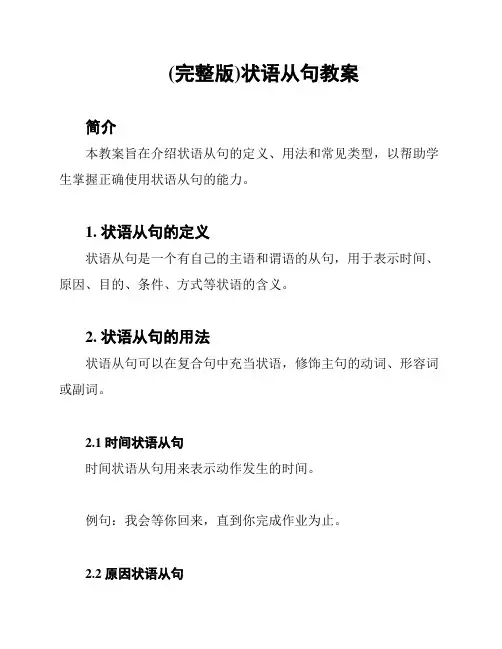
(完整版)状语从句教案简介本教案旨在介绍状语从句的定义、用法和常见类型,以帮助学生掌握正确使用状语从句的能力。
1. 状语从句的定义状语从句是一个有自己的主语和谓语的从句,用于表示时间、原因、目的、条件、方式等状语的含义。
2. 状语从句的用法状语从句可以在复合句中充当状语,修饰主句的动词、形容词或副词。
2.1 时间状语从句时间状语从句用来表示动作发生的时间。
例句:我会等你回来,直到你完成作业为止。
2.2 原因状语从句原因状语从句用来表示主句中的动作的原因或理由。
例句:因为天气太冷,所以我们取消了野餐计划。
2.3 目的状语从句目的状语从句用于表示主句中的动作的目的或意图。
例句:我来这里是为了研究更多的知识。
2.4 条件状语从句条件状语从句用来表示主句中的动作发生的条件。
例句:如果明天下雨,我们就取消郊游活动。
2.5 方式状语从句方式状语从句用来表示主句中的动作发生的方式或方法。
例句:她以一种非常温柔地方式对待孩子们。
3. 练请在下列句子中选择正确的状语从句填空:1. 我会等你回来,______你完成作业为止。
A. 除非B. 既然C. 因为2. 她去超市买了很多东西,______家里没有食物了。
A. 因此B. 只要C. 不管3. 如果你迟到了,______开车去学校。
A. 我们会B. 我会C. 我们不会参考答案:1. A2. A3. B结语通过学习本教案,希望学生们能够理解并正确运用状语从句,提高英语写作和口语表达的能力。
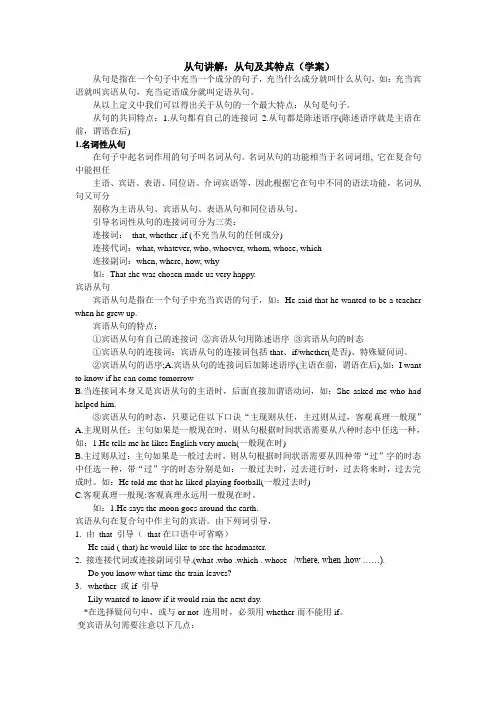
从句讲解:从句及其特点(学案)从句是指在一个句子中充当一个成分的句子,充当什么成分就叫什么从句,如:充当宾语就叫宾语从句,充当定语成分就叫定语从句。
从以上定义中我们可以得出关于从句的一个最大特点:从句是句子。
从句的共同特点:1.从句都有自己的连接词 2.从句都是陈述语序(陈述语序就是主语在前,谓语在后)1.名词性从句在句子中起名词作用的句子叫名词从句。
名词从句的功能相当于名词词组, 它在复合句中能担任主语、宾语、表语、同位语、介词宾语等,因此根据它在句中不同的语法功能,名词从句又可分别称为主语从句、宾语从句、表语从句和同位语从句。
引导名词性从句的连接词可分为三类:连接词:that, whether ,if (不充当从句的任何成分)连接代词:what, whatever, who, whoever, whom, whose, which连接副词:when, where, how, why如:That she was chosen made us very happy.宾语从句宾语从句是指在一个句子中充当宾语的句子,如:He said that he wanted to be a teacher when he grew up.宾语从句的特点:①宾语从句有自己的连接词②宾语从句用陈述语序③宾语从句的时态①宾语从句的连接词:宾语从句的连接词包括that、if/whether(是否)、特殊疑问词。
②宾语从句的语序;A.宾语从句的连接词后加陈述语序(主语在前,谓语在后),如:I want to know if he can come tomorrowB.当连接词本身又是宾语从句的主语时,后面直接加谓语动词,如:She asked me who had helped him.③宾语从句的时态,只要记住以下口诀“主现则从任,主过则从过,客观真理一般现”A.主现则从任:主句如果是一般现在时,则从句根据时间状语需要从八种时态中任选一种,如:1.He tells me he likes English very much(一般现在时)B.主过则从过:主句如果是一般过去时,则从句根据时间状语需要从四种带“过”字的时态中任选一种,带“过”字的时态分别是如:一般过去时,过去进行时,过去将来时,过去完成时。
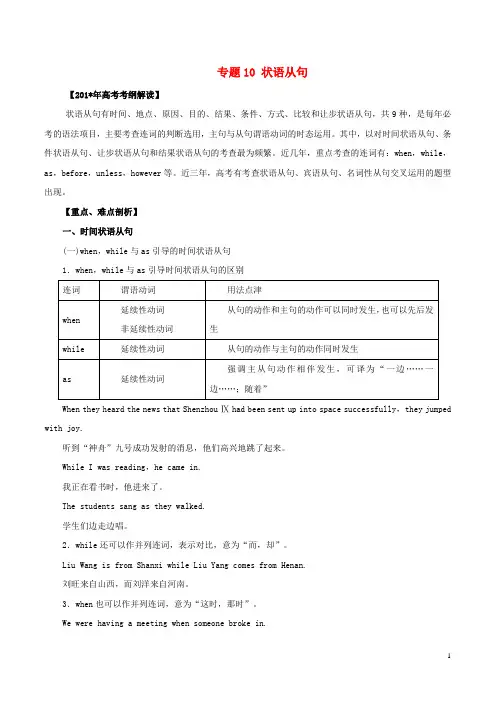
专题10 状语从句【201*年高考考纲解读】状语从句有时间、地点、原因、目的、结果、条件、方式、比较和让步状语从句,共9种,是每年必考的语法项目,主要考查连词的判断选用,主句与从句谓语动词的时态运用。
其中,以对时间状语从句、条件状语从句、让步状语从句和结果状语从句的考查最为频繁。
近几年,重点考查的连词有:when,while,as,before,unless,however等。
近三年,高考有考查状语从句、宾语从句、名词性从句交叉运用的题型出现。
【重点、难点剖析】一、时间状语从句(一)when,while与as引导的时间状语从句1.when,while与as引导时间状语从句的区别When they heard the news that Shenzhou Ⅸ had been sent up into space successfully,they jumped with joy.听到“神舟”九号成功发射的消息,他们高兴地跳了起来。
While I was reading,he came in.我正在看书时,他进来了。
The students sang as they walked.学生们边走边唱。
2.while还可以作并列连词,表示对比,意为“而,却”。
Liu Wang is from Shanxi while Liu Yang comes from Henan.刘旺来自山西,而刘洋来自河南。
3.when也可以作并列连词,意为“这时,那时”。
We were having a meeting when someone broke in.我们正在开会这时突然有人闯了进来。
(二)before与since引导的时间状语从句1.before与since的常用句式It will be two years before he leaves the country.再过两年他才会离开这个国家。
It wasn't two years before he left the country.不到两年他就离开了这个国家。
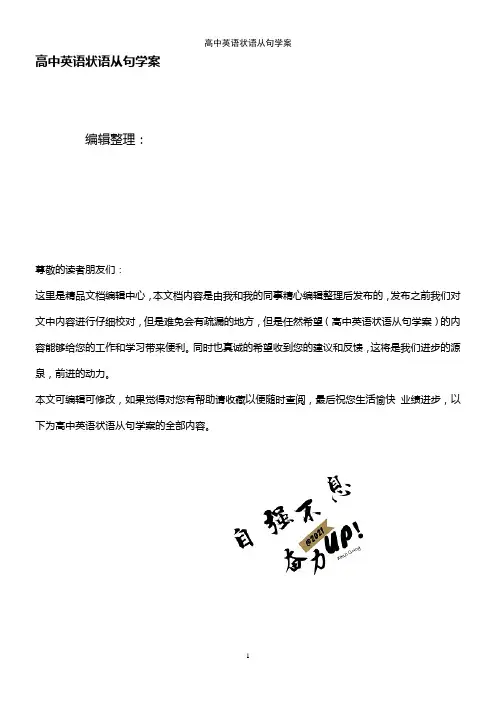
高中英语状语从句学案编辑整理:尊敬的读者朋友们:这里是精品文档编辑中心,本文档内容是由我和我的同事精心编辑整理后发布的,发布之前我们对文中内容进行仔细校对,但是难免会有疏漏的地方,但是任然希望(高中英语状语从句学案)的内容能够给您的工作和学习带来便利。
同时也真诚的希望收到您的建议和反馈,这将是我们进步的源泉,前进的动力。
本文可编辑可修改,如果觉得对您有帮助请收藏以便随时查阅,最后祝您生活愉快业绩进步,以下为高中英语状语从句学案的全部内容。
专题四——状语从句英语中的状语从句用来修饰谓语或者整个主句按照功能可以分为:时间状从,地点状从,原因状从,结果状从,条件状从,目的状从,让步状从,方式状从,比较状从。
1、时间状语从句(1)when、while、 as用法一览表。
(2)引导时间状语从句的连接词除上述外还有:①as soon as , directly, immediately, the moment, the minute … 一……就As soon as I have finished it , I’ll give yu a call。
He made for the door directly he heard the knock.②h ardly / scarcely … when,no sooner … than,表示“一……就”We had hardly got / Hardly had we got into the country when it began to rain.No sooner had he arrived / He had no sooner arrived than she started complaining.③till, not … until …, until, before, since before 用法 not until 强调,倒桩 since用法Don’t get off the bus until it has stop ped. Not until years later could I realize the value of that kind of giving.He waited for his father until(till)it was twelve o’clock. It was not until years later that I could realize the value of that kind of givingIt is/ has been +一段时间+since从句非延续,自。
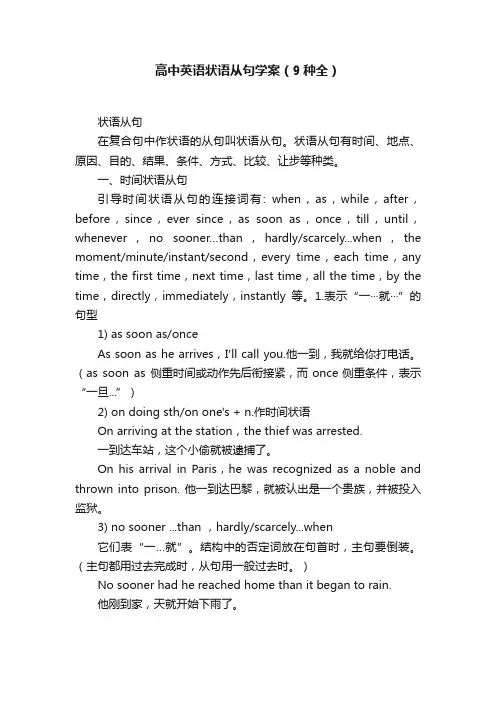
高中英语状语从句学案(9种全)状语从句在复合句中作状语的从句叫状语从句。
状语从句有时间、地点、原因、目的、结果、条件、方式、比较、让步等种类。
一、时间状语从句引导时间状语从句的连接词有: when,as,while,after,before,since,ever since,as soon as,once,till,until,whenever,no sooner…than,hardly/scarcely...when,the moment/minute/instant/second,every time,each time,any time,the first time,next time,last time,all the time,by the time,directly,immediately,instantly等。
1.表示“一···就···”的句型1) as soon as/onceAs soon as he arrives,I'll call you.他一到,我就给你打电话。
(as soon as 侧重时间或动作先后衔接紧,而once侧重条件,表示“一旦...”)2) on doing sth/on one's + n.作时间状语On arriving at the station,the thief was arrested.一到达车站,这个小偷就被逮捕了。
On his arrival in Paris,he was recognized as a noble and thrown into prison. 他一到达巴黎,就被认出是一个贵族,并被投入监狱。
3) no sooner ...than ,hardly/scarcely...when它们表“一…就”。
结构中的否定词放在句首时,主句要倒装。
(主句都用过去完成时,从句用一般过去时。
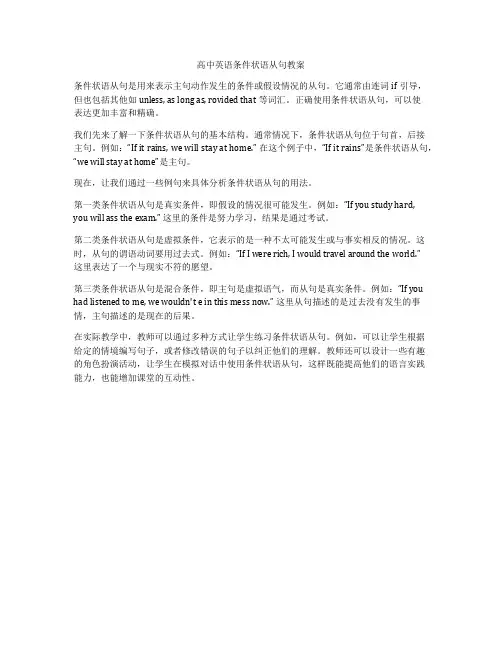
高中英语条件状语从句教案条件状语从句是用来表示主句动作发生的条件或假设情况的从句。
它通常由连词if引导,但也包括其他如unless, as long as, rovided that等词汇。
正确使用条件状语从句,可以使表达更加丰富和精确。
我们先来了解一下条件状语从句的基本结构。
通常情况下,条件状语从句位于句首,后接主句。
例如:“If it rains, we will stay at home.” 在这个例子中,“If it rains”是条件状语从句,“we will stay at home”是主句。
现在,让我们通过一些例句来具体分析条件状语从句的用法。
第一类条件状语从句是真实条件,即假设的情况很可能发生。
例如:“If you study hard, you will ass the exam.” 这里的条件是努力学习,结果是通过考试。
第二类条件状语从句是虚拟条件,它表示的是一种不太可能发生或与事实相反的情况。
这时,从句的谓语动词要用过去式。
例如:“If I were rich, I would travel around the world.”这里表达了一个与现实不符的愿望。
第三类条件状语从句是混合条件,即主句是虚拟语气,而从句是真实条件。
例如:“If you had listened to me, we wouldn't e in this mess now.” 这里从句描述的是过去没有发生的事情,主句描述的是现在的后果。
在实际教学中,教师可以通过多种方式让学生练习条件状语从句。
例如,可以让学生根据给定的情境编写句子,或者修改错误的句子以纠正他们的理解。
教师还可以设计一些有趣的角色扮演活动,让学生在模拟对话中使用条件状语从句,这样既能提高他们的语言实践能力,也能增加课堂的互动性。
2013高考英语:(01)二轮语法学案(状语从句)(训练题配答案或解析)本单元的语法重点为状语从句状语从句可分为时间、地点、目的、原因、结果、行为方式、条件、让步、比较九种。
引导这些状语从句的连词主要有:lt is long before…(过了好久才……)lt is not long before…(过了不久就……)2.till与until(till一般不放在句首)(1)持续性动词(肯定式)+until(直到……为止)(2)瞬间动词(否定式)上until(直到……才)(3)强调句型:It is not until…that…eg:I waited until(till)he had finished his work.我一直等到他完成工作。
FIe didn't go to bed until/till 1 came back.直到我回来.他才去睡觉。
It Was not until l came back that hc went to bed.直到我回来.他才去睡觉。
3.since意为“自从……以来”。
since一瞬间动词过去式(从该动作发生时算起)since-一持续性动词的过去式(从该动作结束时算起)eg:He has been working very hard since he entered the factory.自从他人厂以来一直努力工作。
4.if与unless都可引导条件状语从句.在许多情况下unless可以与.f…not交换使用。
但在下列情况下不可互换:(1)if not引导非真实条件句。
(2)unless从句中可用否定词.在.f…not从句中一般不再用否定词。
eg:I’ll go unless no one else does.除非没有其他人去我才会去。
5.在so+adj/adv+that clause中.当把so+adj/adv.部分放在句首时.该句主句应为倒装语序。
状语从句状语从句在句子中可修饰谓语、形容词或是整个句子,它可以用来表示时间、地点、原因、目的、结果、条件、方式、比较、让步等。
一、时间状语从句可由when, as, while, after, before, till(until), since, by the time, once, as soon as, the moment引导When I came into the office, the teachers were having a meeting.He started as soon as he received the news.Once you see him, you will never forget him.注意:not…until的用法和强调句结构。
如:I didn’t realize that I had left my key in the office until I arrived home.It was not until I arrived home that I realized that I had left my key in the office.在hardly/scarcely…when… , no sooner…than…句式中,把hardly/scarcely/no sooner置于句首时,第一个分句采用部分倒装语序。
第一个分句用过去完成时,第二个分句用一般过去时Hardly had he sat down when there was a knock at the door.No sooner had I gone to bed than I went to sleep.二、原因状语从句原因状语从句时表示原因或理由的,引导这类从句的最常用的是because, since, as, now that等,for表示因果关系时为并列连词,常位于句尾,其前有逗号,语气最弱。
状语从句教学案状语从句是复合句中的一种从句类型,用来修饰主句中的动词、形容词或副词,对其进行详细说明。
在英语学习中,状语从句的运用是提高语言表达能力的关键之一。
本教学案将着重介绍状语从句的定义、分类及正确运用的方法,帮助学生掌握并灵活运用状语从句。
一、引入(100字)1. 标题:状语从句教学案2. 格式:教学案状语从句是英语中的一个重要知识点,也是提高语言表达能力的重要手段。
通过学习状语从句,可以丰富语言的表达方式,提高语言表达的准确性和流畅度。
本教学案将以具体例子和练习为主,帮助学生掌握状语从句的相关知识和正确运用方法。
二、知识点介绍(800字)1. 状语从句的定义状语从句是一个从属于主句的句子,主要用来修饰主句中的动词、形容词或副词,对其进行详细说明。
状语从句通常由连词引导,位置可以在主句之前、之中或之后。
2. 状语从句的分类a) 时间状语从句:用来表示主句动作发生的时间,常用的连词有when、while、before等。
b) 地点状语从句:用来表示主句动作发生的地点,常用的连词有where、wherever等。
c) 原因状语从句:用来表示主句动作的原因,常用的连词有because、since、as等。
d) 条件状语从句:用来表示主句动作的条件,常用的连词有if、unless等。
e) 目的状语从句:用来表示主句动作的目的,常用的连词有so that、in order that等。
f) 结果状语从句:用来表示主句动作的结果,常用的连词有so...that、such...that等。
g) 方式状语从句:用来表示主句动作的方式,常用的连词有as、as if等。
3. 状语从句的引导词的使用不同类型的状语从句需要使用不同的引导词,根据状语从句的分类掌握相应的引导词的用法非常重要。
同时,学生还需要注意一些特殊状语从句的引导词的用法,如时间状语从句中的"when"和"while"的区别等。
状语从句状语从句在句中作状语,修饰主句中的动词、形容词或副词等。
状语从句放在主句之前时,常用逗号分开;放在主句之后,一般不用逗号。
状语从句按其意义和作用可分为时间、条件、原因、让步、目的、结果、方式、比较、地点9种。
1.时间状语从句1) 时间状语从句常用连词有when, as, while, before, after, since, till, until, as soon as, hardly … when …, no sooner … than …., the moment等。
2) 时间状语从句一般不用将来时。
因此,主句若为将来时,时间状语从句要用一般现在时。
I’ll go on with the work when I come back tomorrow.3) 连词when, while, as都表示“当……的时候”,但有区别。
as 多用于口语中,强调“同一时间”或“一前一后”,有时还有“随着”的含义。
As he was eating his breakfast, he heard the door bell ring. (强调同一时间)As going out, it began to rain. (强调两个动作紧接着先后发生)As spring warms the good earth, all flowers being to bloom. (as有“随着”的含义)when 强调“特定时间”。
When spring comes, he feels like a trip.When he was eating his breakfast, he heard the door bell ring.while 表示的时间是一段,而不是一点。
while 有时还有对比的含义,意为“然而”。
While he was eating his breakfast, he heard the door bell ring. (强调吃饭的过程)While I was reading, he was playing. (有对比的含义)4) till / until表示“一直到……”时,主句和从句都用肯定式;表示“直到……才……”时,主句用否定式,从句用肯定式。
状语从句一.概念及分类:句子可以分为简单句,并列句和复合句;复合句中从句的从属地位,表现为结构完整的句子只相当于一个词的地位,根据其所相当的词性,分别为形容词从句,副词从句和名词从句。
形容词从句可作也只作定语,故等于定语从句;副词从句可作也只作状语,故为状语从句,而名词从句可作不同的成分,依其所作成分的不同分别为主语从句、宾语从句、表语从句和同位语从句。
副词从句作状语,往往修饰的是谓语动词或者整个句子,因此不像定语从句或名词从句一样与某一个部分纠结在一起。
它往往与主句相对,与主句界限分明。
位于句首时,状语从句还常以逗号与主句分开。
状语从句可分为:1.时间状语从句;2.地点状语从句;3.原因状语从句; 4.条件状语从句;5.目的状语从句;6.让步状语从句; 7.比较状语从句; 8.方式状语从句;9.结果状语从句。
二.时间状语从句(一)when, while和as1,when, 观察下面例句,总结其用法:When I lived there, I used to go to the seashore on Sundays.When the film ended, the people went back.总结:从句表示的动作_________________________________,主句和从句的先后关系_______________________________________________________________________。
在下列句子中,when 的含义是:_____________,做为并列连词。
We were having a meeting when someone broke in.We were about to set off on our way when it suddenly began to rainShe was on the point of going to shop when the telephone rang..Hardly had I arrived when the train left.He had just finished his home work when someone asked him to play basketball.总结:_________________________________: _________________________________________________________________; ______________________________________________________________________________________________ 观察下列句子中when 的含义:It was foolish of you to take a taxi when you could easily walk there in five minutes.Why do you want a new job when you have got such a good one?when 表示条件,意思接近“在…...情况下”whenever:I go to the theater whenever I get the chance.(每当,每次)Come and see me whenever you want to.(在任何时候)2,while ,观察例句并总结用法:We were listening/listened to the radio while he was reading newspaper.I like tea while helike coffee.Please don’t talk so loud while others are working.总结:while引导的从句谓语动词必须是_______________________, 常用___________时。
状语从句9种1.时间状语从句常⽤引导词:when, as, while, as soon as, before, after, since , till, until 特殊引导词:the minute, the moment, the second, every time, the day,theinstant, immediately , directly, no sooner … than, hardly …when, scarcely …whenI didn't realize how special my mother was until I became an adult. While John was watching TV, his wife was cooking.The childre n ran away from the orchard果园),the mome nt they saw the guard.No sooner had I arrived home ,then it began to rain.Every time I listen to your advice, I get into trouble.2.地点状语从句常⽤引导词:where特殊引导词:wherever, anywhere, everywhereGenerally, air will be heavily polluted where there are factories. Wherever you go, you should work hard.地点状语从句§4地点状语从句(adverbial clause of place) 地点状语从句⼀般由连接副词where, wherever 等引导,已经形成了固定的句型,例如:句型1: Where+地点从句,(there)+主句。
状语从句在复合句中作状语的从句叫状语从句。
状语从句有时间、地点、原因、目的、结果、条件、方式、比较、让步等种类。
一、时间状语从句引导时间状语从句的连接词有: when, as, while, after, before, since, ever since, as soon as, once, till, until, whenever, no sooner…than, hardly/scarcely...when, themoment/minute/instant/second, every time, each time, any time, the first time, next time, last time, all the time, by the time, directly, immediately, instantly等。
1.表示“一···就···”的句型1) as soon as/onceAs soon as he arrives, I'll call you.他一到,我就给你打电话。
(as soon as 侧重时间或动作先后衔接紧,而once侧重条件,表示“一旦...”)2) on doing sth/on one's + n.作时间状语On arriving at the station, the thief was arrested.一到达车站,这个小偷就被逮捕了。
On his arrival in Paris, he was recognized as a noble and thrown into prison. 他一到达巴黎,就被认出是一个贵族,并被投入监狱。
3) no sooner ...than , hardly/scarcely...when它们表“一…就”。
结构中的否定词放在句首时,主句要倒装。
(主句都用过去完成时,从句用一般过去时。
)No sooner had he reached home than it began to rain.他刚到家,天就开始下雨了。
Hardly/Scarcely had I entered the room when the phone rang.我一进屋,电话就响了。
当no sooner, hardly, scarcely不放在句首时,主句不倒装,如:I had no sooner reached the bus stop than the bus started.我刚到车站,车就开走了。
I had scarcely(hardly)entered the room when the phone rang.4)the moment, the instant, the minute, the secondThe moment I saw him, I recognized him.我一看见他,就认出了他。
We'll leave the minute you are ready.你一准备好,我们就出发。
5)有些副词如:instantly, immediately, directly可用作连词,后接从句。
I left immediately the clock struck 5.我刚走,钟就敲了五点。
2. when, while, as引导时间状语从句1) when的用法①when既可指时间点,也可指时间段(即:从句动词可以是短暂的也可是延续的);主从句动作可同时也可先后发生。
I was thin when I was a child.当我是个孩子的时候,我很瘦。
It was raining when I arrived.我到达时,天正在下雨。
②在when引导时间状语从句时,如果从句主语与主句主语相同或为it,且从句有be动词,则从句可省主语和be动词,如:When (you are) in trouble, you can visit this man.当你有麻烦时,可以找这个人。
She is always listening to music when(she is) doing her homework. 当她做作业时,总是听音乐。
③when在下列结构中, 译成“这时”,它引导的是并列句be about to do ... when, be doing ... when, had done ···when,be on one's way ... when, be on the point of doing ... when(参见“连词”部分when的用法)2)while用法while只能指一段时间,从句中的动词必须是延续性动词。
强调某一段时间内发生主句动作,相当于during the time that....My mother was cooking while I was doing my homework.当我在做作业时,妈妈在做饭。
I am safe while I am here.我在这儿的时候,我很安全。
while除引导时间状语从句外,还引导对比句,作“然而”讲;并可在句首引出让步状语从句作“虽然···但”讲。
I like watching TV, while he likes reading.我喜欢看电视,而他喜欢读书。
While he has his own car, he often uses mine.尽管他自己有车,他却常用我的。
3) as的用法①as引导时间状语从句时常可和when换用,但较强调同时发生,多指短暂动作。
As I left the house, I forgot the key.我离家时,忘了带钥匙。
②as还可说明两种正在发展或变化的情况,“随着...”的意思,表时间的推移。
如:As I get older, I get more optimistic.随着年龄的增长,我变得更加乐观。
③as表“一边…一边…”,引出伴随动作。
He hurried home, looking behind as he went.他匆忙地回家,边走边往后看。
④用以强调两个动作紧接着发生。
As he was going out, it began to rain.当他出去的时候,天开始下雨了。
⑤as有时引出一个名词,相当于一个时间状语从句。
As a boy (when he was a boy), he was hopeless at maths.当他是孩子时,他对数学失去希望。
3. before引导的时间状语从句①before引导的时间状语从句不用否定式谓语。
Before they got to the bus stop, the bus had gone.在他们到达公共汽车站之前,公共汽车已经走了。
②在“It be + 时间段+ before从句”句型中,肯定句译成“…(之后)才”,否定句译成“…就”。
该句型有一般过去时、过去将来时、一般将来时三个时态,且有否定句。
It will be some time before... do...It was some time before...did...It would be some time before...did...It was long before...did...“很久才···”It wasn't long before...did...“不久就...”It will be many years before the chemicals start to escape fromthe containers. 多年以后化学物质才开始从容器中逃逸。
It was not long before he came back.不久他就回来了。
It was a long time before he got to sleep again.很久他才再次入睡。
It was a week before he could tell his story.一个星期后他才能讲述他的经历。
It wasn't long before he told us about himself.不久他就给我们讲述了他自己的故事。
▲before可译成“未来得及”He had measured me before I could get a word.我还未来得及插话,他就量好了尺寸。
▲before可译成“趁着还没”I'll write it down before I forget.趁着还没忘我要把它写下来。
4. until和till1)“延续性动词肯定式+until”表示“动作延续到…为止,”译为“直到…为止”,如:I waited for him until he came back. 我一直等到他回来。
2)“终止性动词的否定式+ until”表示“直到···才”。
He didn't go to bed until he had finished his work. 直到完成工作他才睡觉。
3)用于强调句式“It is not until ...that ...”It was not until the professor came that we began the experiment.在教授到来之后,我们才开始实验。
4) not until放在句首时,主句倒装。
Not until he graduated did he succeed in obtaining this compound. 直到他毕业他才成功获得这种化合物。
句首和强调句中要用until,而不用till;not...until...句型中不用till。
5. since引导时间状语从句,意为“自从…时起”,主句要用完成时。
Mr. Li has been here since he came back.自从李先生回来以后,他一直在这儿。
I haven't heard from him since he lived here.自从他住在这儿以来,我就没有收到过他的来信。
I've known Mr. Smith since I was a boy.我小的时候就认识史密斯先生了。
6.时间状语从句的省略式当时间状语从句的主语和主句主语相同或为it,从句又含be动词时,从句可省略主语和be动词。
在不产生歧义时,连词也可省去。